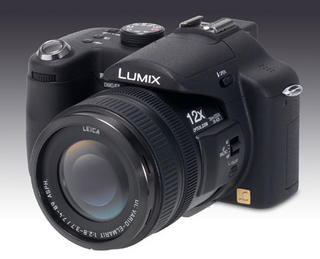Panasonic Lumix DMC-FZ30

Design Technica Reviews Panasonic Lumix DMC-FZ30 and says:
The Panasonic Lumix DMC-FZ30 is available in black or silver finish; I much prefer the black since it gives a heavy D-SLR vibe. When you snap on the lens hood, only the savviest photographers will know any different. However, I’d put the shade on once to admire the view then return it to the box since you’ll run into vignetting problems when using the flash. The camera does have a very clean look with a minimum amount of keys and dials.
Once the battery was charged and a high-speed 1GB SanDisk Extreme III card was loaded it was time to set up the camera. Even though the camera has only a 2-inch LCD, quality is so good, it’s a breeze to read (the Sony DSC-H1 has a 2.5-incher). Setting the date and time was simple with the four-way controller. It doesn’t have a “set” or enter key so making adjustments was a bit different than other digicams but it’s not really a big deal. As noted, the camera has a RAW option (as well as TIFF and JPEG). We set the camera to RAW and immediately saw why a 1GB card is critical since it holds approximately 40 images compared to 200-plus JPEGs at best compression (3264 x 2448 pixels). And definitely opt for high-speed to help save the huge files and to get the best video quality (640 x 480 pixels at 30 fps).
With a camera that had so much going for it—a great 12x Leica lens, optical image stabilization and 8MP resolution—the Lumix DMC-FZ30 should have rung the bell. It didn’t. The price is right too: it costs around $600. By comparison an 8MP D-SLR like the Canon Digital Rebel XT is $800 for the body and an image stabilized 100-400mm zoom would set you back another $1,400! Unfortunately, digital noise is a problem at higher ISOs. Bummer. If tweaking RAW files in PhotoShop CS2 is your style, then this camera is worth a long look. Other shoppers should consider mega zoom cameras from other companies, even though there is no direct competitor.
After some time in the field, it was time to view the results onscreen and to make some 8.5x11 prints. It was at this time that the DMC-FZ30 versus an 8MP or even a 6MP D-SLR contest came to a screeching halt (the D-SLRs win hands down). Making full bleed prints with no editing or enhancements the amount of noise was very high, so much so that was a bit disconcerting particularly at 200 and 400. There was some purple fringing too but nothing as bothersome as the noise. At 80 and 100 photos were good but not spectacular. Having just shot with a 6MP Konica Minolta Maxxum 5D D-SLR with excellent results, the comparison was all the more jarring. The highly lauded 6MP FujiFilm FinePix F10 for $399 handled noise, much, much better with an ISO reaching 1600. Sure I could make smaller prints but that defeats the purpose of an 8MP camera. I also could spend time with Adobe Photoshop CS2 cleaning up the RAW files but that adds $500 to the total cost, not an insignificant sum in anyone’s universe. On the plus side, the flash was quite good and accurate thanks to the AF Assist lamp (don’t bother with the supplied sunshade). Videos were VHS level and you can use the zoom while recording clips. Again, these are O.K. for short movies but definitely not a replacement for a MiniDV camcorder.
With a camera that had so much going for it—a great 12x Leica lens, optical image stabilization and 8MP resolution—the Lumix DMC-FZ30 should have rung the bell. It didn’t. The price is right too: it costs around $600. By comparison an 8MP D-SLR like the Canon Digital Rebel XT is $800 for the body and an image stabilized 100-400mm zoom would set you back another $1,400! Unfortunately, digital noise is a problem at higher ISOs. Bummer. If tweaking RAW files in PhotoShop CS2 is your style, then this camera is worth a long look. Other shoppers should consider mega zoom cameras from other companies, even though there is no direct competitor.
Pros:
- Terrific zoom range
- Built-in optical image stabilization (2 modes)
- Great feel with zoom and manual focus
- Excellent menus
- High-quality 2-inch LCD screen and EVF
Cons:
- Very noisy above 100 ISO
- No USB Hi-Speed connection
- Supplied software lacks RAW conversion

0 Comments:
Post a Comment
<< Home